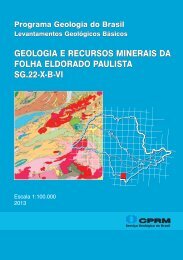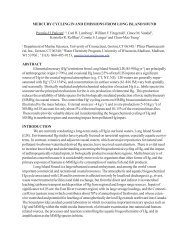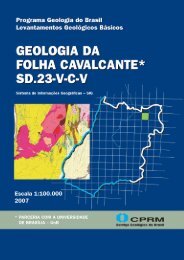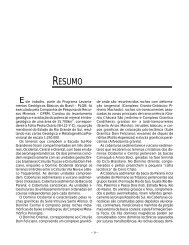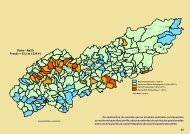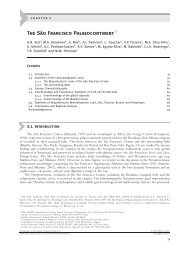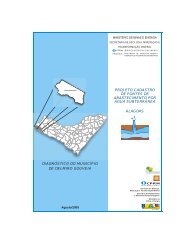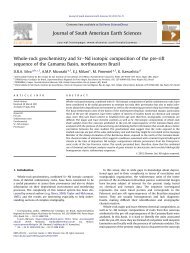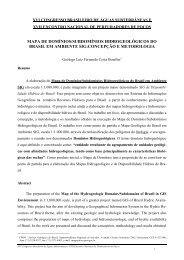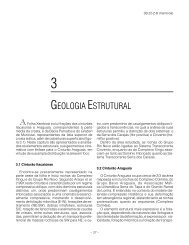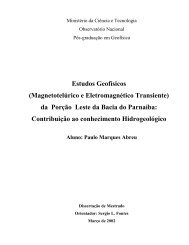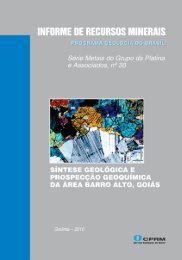Origin of the CO2-only fluid inclusions in the ... - CPRM
Origin of the CO2-only fluid inclusions in the ... - CPRM
Origin of the CO2-only fluid inclusions in the ... - CPRM
Create successful ePaper yourself
Turn your PDF publications into a flip-book with our unique Google optimized e-Paper software.
Fig. 8. P–T diagram show<strong>in</strong>g isochores calculated for <strong>fluid</strong> <strong><strong>in</strong>clusions</strong> <strong>in</strong> <strong>the</strong> different<br />
ve<strong>in</strong> types <strong>of</strong> <strong>the</strong> Carará gold deposit: LGQ (low-grade quartz), HGQ (high-grade<br />
quartz), QTV (late barren quartz quartz-tourmal<strong>in</strong>e ve<strong>in</strong>let). Types 1 and 2 are onephase<br />
carbonic and two-phase aqueous-carbonic <strong>fluid</strong> <strong><strong>in</strong>clusions</strong>, respectively. The<br />
dashed curve labelled 10/6 represents <strong>the</strong> solvus for <strong>the</strong> CO 2–H 2O–NaCl system with<br />
XCO 2 <strong>of</strong> 10 mol.% and 6 wt.% NaCl equiv. The thick solid l<strong>in</strong>e labelled c.c. is <strong>the</strong> critical<br />
curve for H 2O–CO 2 (both curves are from Bowers and Helgeson, 1983). The dotted l<strong>in</strong>e<br />
represents <strong>the</strong> geo<strong>the</strong>rmal gradient assum<strong>in</strong>g lithostatic overburden. The dark and light<br />
grey shaded areas represent <strong>the</strong> peak and retrogressive metamorphic conditions,<br />
respectively, for <strong>the</strong> host<strong>in</strong>g sequence, as determ<strong>in</strong>ed by Faraco et al. (2006). The<br />
stippled area def<strong>in</strong>es <strong>the</strong> estimated predom<strong>in</strong>ant P–T conditions for <strong>the</strong> entrapment <strong>of</strong><br />
<strong>the</strong> CO 2-rich <strong>fluid</strong> and <strong>the</strong> arrowed l<strong>in</strong>e represents <strong>the</strong> possible P–T path followed by<br />
<strong>the</strong> CO 2 <strong>fluid</strong>.<br />
concentration could be ma<strong>in</strong>ta<strong>in</strong>ed by reduced sulphur complexes.<br />
Moreover, studies <strong>of</strong> Lai and Chi (2007) suggest that <strong>CO2</strong>-rich vapour is<br />
capable <strong>of</strong> transport<strong>in</strong>g large amounts <strong>of</strong> Cu, and possibly Au.<br />
8. Conclusions<br />
The petrographic, micro<strong>the</strong>rmometric and micro-Raman study <strong>of</strong> <strong>the</strong><br />
peculiar assemblage <strong>of</strong> CO 2-rich <strong>fluid</strong> <strong><strong>in</strong>clusions</strong> with no visible water<br />
sampled from <strong>the</strong> Au–quartz ve<strong>in</strong> <strong>of</strong> <strong>the</strong> Carará deposit, <strong>in</strong>tegrated with<br />
regional geological <strong>in</strong>formation and available isotopic data allow <strong>the</strong><br />
follow<strong>in</strong>g observations and conclusions:<br />
(1) Primary and pseudo-secondary CO 2-rich <strong>fluid</strong> <strong><strong>in</strong>clusions</strong><br />
display variable densities that reflect re-equilibration dur<strong>in</strong>g<br />
and after trapp<strong>in</strong>g.<br />
(2) The densest (N0.9 g/cm 3 ) <strong><strong>in</strong>clusions</strong> approximate <strong>the</strong> conditions<br />
<strong>of</strong> <strong>the</strong> parental <strong>fluid</strong>. This parental <strong>fluid</strong> may be ei<strong>the</strong>r an orig<strong>in</strong>ally<br />
<strong>CO2</strong>-rich <strong>fluid</strong> or a <strong>fluid</strong> produced by phase separation <strong>of</strong> an<br />
carbonic-aqueous <strong>fluid</strong> hav<strong>in</strong>g XCO 2N0.8.<br />
(3) The <strong>CO2</strong> <strong>fluid</strong> was channelled <strong>in</strong> fractures and trapped <strong>in</strong> ve<strong>in</strong>s,<br />
whereas an H2O-rich <strong>fluid</strong> provoked <strong>the</strong> hydrous alteration<br />
around <strong>the</strong> ve<strong>in</strong>.<br />
(4) Most <strong>fluid</strong> <strong><strong>in</strong>clusions</strong> were trapped and/or re-equilibrated at 350<br />
to 475 °C and 1.8 to 3.6 kbar, which implies 7 to 12 km <strong>of</strong> depth<br />
for ve<strong>in</strong> formation. Trapp<strong>in</strong>g, however, commenced earlier, at<br />
least <strong>in</strong> <strong>the</strong> amphibolite facies conditions.<br />
(5) The potential deep-seated sources for <strong>the</strong> <strong>CO2</strong> <strong>fluid</strong> are <strong>the</strong><br />
2074 Ma old charnockites and/or <strong>the</strong> coeval granulite facies<br />
metamorphism.<br />
(6) The role <strong>of</strong> CO 2, whe<strong>the</strong>r capable <strong>of</strong> transport<strong>in</strong>g gold complexes or,<br />
alternatively, as an agent to provide adequate physico-chemical<br />
conditions for gold transport and deposition, is not yet understood.<br />
Acknowledgements<br />
Field work was done dur<strong>in</strong>g <strong>the</strong> RENCA Project developed by <strong>CPRM</strong>/<br />
Geological Survey <strong>of</strong> Brazil. The authors thank <strong>the</strong> thoughtful comments<br />
<strong>of</strong> two OGR anonymous reviewers. The senior author acknowledges <strong>the</strong><br />
E.L. Kle<strong>in</strong>, K. Fuzikawa / Ore Geology Reviews 37 (2010) 31–40<br />
Brazilian Conselho Nacional de Desenvolvimento Científico e Tecnológico<br />
(CNPq) for research grant 306994/2006-0.<br />
References<br />
Baker, T., 2002. Emplacement depth and carbon dioxide-rich <strong>fluid</strong> <strong><strong>in</strong>clusions</strong> <strong>in</strong><br />
<strong>in</strong>trusion-related gold deposits. Economic Geology 97, 1111–1117.<br />
Bakker, R.J., Jansen, B.H., 1991. Experimental post-entrapment water loss from syn<strong>the</strong>tic<br />
<strong>CO2</strong>–H2O <strong><strong>in</strong>clusions</strong> <strong>in</strong> natural quartz. Geochimica et Cosmochimica Acta 55,<br />
2215–2230.<br />
Bowers, T.S., Helgeson, H.C., 1983. Calculation <strong>of</strong> <strong>the</strong> <strong>the</strong>rmodynamic and geochemical<br />
consequences <strong>of</strong> nonideal mix<strong>in</strong>g <strong>in</strong> <strong>the</strong> system H 2O–CO 2–NaCl on phase relations<br />
<strong>in</strong> geological systems: equation <strong>of</strong> state for H 2O–CO 2–NaCl <strong>fluid</strong>s at high pressures<br />
and temperatures. Geochimica et Cosmochimica Acta 47, 1247–1275.<br />
Bray, C.J., Spooner, E.T.C., Thomas, A.V., 1991. Fluid <strong>in</strong>clusion volatile analysis by heated<br />
crush<strong>in</strong>g, on-l<strong>in</strong>e gas chromatography: application to Archaean <strong>fluid</strong>s. Journal <strong>of</strong><br />
Geochemical Exploration 42, 167–192.<br />
Carvalho, J.M.A., Faraco, M.T.L., Kle<strong>in</strong>, E.L., 1995. Metallogenic-Geochemical Map <strong>of</strong> Gold <strong>in</strong><br />
Amapá and NW Pará States, Scale 1:500, 000: Explanatory Note. <strong>CPRM</strong>, Belém. 5 pp.<br />
Chacko, T., Hu, X., Mayeda, T.K., Clayton, R.N., Goldsmith, J.R., 1996. Oxygen isotope<br />
fractionations <strong>in</strong> muscovite, phlogopite, and rutile. Geochimica et Cosmochimica Acta 60,<br />
2595–2608.<br />
Chi, G., Liu, Y., Dubé, B., 2009. Relationship between CO 2-dom<strong>in</strong>ated <strong>fluid</strong>s, hydro<strong>the</strong>rmal<br />
alterations and gold m<strong>in</strong>eralization <strong>in</strong> <strong>the</strong> Red Lake greenstone belt, Canada. Applied<br />
Geochemistry 24, 504–516.<br />
Cox, S.F., 1995. Fault<strong>in</strong>g processes at high <strong>fluid</strong> pressures: an example <strong>of</strong> fault valve<br />
behavior from <strong>the</strong> Wattle Gully Fault, Victoria, Australia. Journal <strong>of</strong> Geophysical<br />
Research 100 (B7), 12841–12859.<br />
Crawford, M.L., Hollister, L.S., 1986. Metamorphic <strong>fluid</strong>s: <strong>the</strong> evidence from <strong>fluid</strong> <strong><strong>in</strong>clusions</strong>.<br />
In: Wal<strong>the</strong>r, J.V., Wood, B.J. (Eds.), Fluid Rock Interaction Dur<strong>in</strong>g Metamorphism.<br />
Physical Geochemistry, vol. 5. Spr<strong>in</strong>ger, New York, pp. 1–35.<br />
De Ronde, C.E.J., Spooner, E.T.C., De Witt, M.J., Bray, C.J., 1992. Shear zone-related, Au quartz<br />
ve<strong>in</strong> deposits <strong>in</strong> <strong>the</strong> Barberton Greenstone Belt, South Africa: field and petrographic<br />
characteristics, <strong>fluid</strong> properties, and light stable isotope geochemistry. Economic<br />
Geology 87, 366–402.<br />
Faraco, M.T.L., Fuzikawa, K., Ramboz, C., McReath, I., 2006. A <strong>fluid</strong> <strong>in</strong>clusion study <strong>in</strong> <strong>the</strong><br />
hydro<strong>the</strong>rmal volcanogenic sulfide and orogenic gold m<strong>in</strong>eralization at <strong>the</strong> Serra<br />
do Ipit<strong>in</strong>ga, Amazon, Brazil. Revista Brasileira de Geociências 36 (suppl. 1), 51–58.<br />
Garba, I., Akande, S.O., 1992. The orig<strong>in</strong> and significance <strong>of</strong> non-aqueous <strong>CO2</strong> <strong>fluid</strong><br />
<strong><strong>in</strong>clusions</strong> <strong>in</strong> <strong>the</strong> auriferous ve<strong>in</strong>s <strong>of</strong> B<strong>in</strong> Yauri, northwestern Nigeria. M<strong>in</strong>eralium<br />
Deposita 27, 249–255.<br />
Graney, J.R., Kesler, S.E., 1995. Gas composition <strong>of</strong> <strong>fluid</strong> <strong>in</strong> ore deposits: is <strong>the</strong>re a<br />
relation to magmas? In: Thompson, J.F.H. (Ed.), Magmas, Fluids and Ore Deposits. :<br />
Short Course Series, vol. 23. M<strong>in</strong>eralogical Association <strong>of</strong> Canada, pp. 221–245.<br />
Hedenquist, J.W., Henley, R.W., 1985. The importance <strong>of</strong> CO 2 on freez<strong>in</strong>g po<strong>in</strong>t<br />
measurements <strong>of</strong> <strong>fluid</strong> <strong><strong>in</strong>clusions</strong>: evidence from active geo<strong>the</strong>rmal systems and<br />
implications for epi<strong>the</strong>rmal ore deposition. Economic Geology 80, 1379–1406.<br />
Higg<strong>in</strong>s, N.C., 1980. Fluid <strong>in</strong>clusion evidence for <strong>the</strong> transport <strong>of</strong> carbonate complexes <strong>in</strong><br />
hydro<strong>the</strong>rmal solutions. Canadian Journal <strong>of</strong> Earth Sciences 17, 823–830.<br />
Ho, S.E., 1987. Fluid <strong><strong>in</strong>clusions</strong>: <strong>the</strong>ir potential as an exploration tool for Archaean gold<br />
deposits.In:Ho,S.E.,Groves,D.I.(Eds.),RecentAdvances<strong>in</strong>Understand<strong>in</strong>gPrecambrian<br />
Gold Deposits. : Publication, vol. 11. Geology Department and University Extension,<br />
University <strong>of</strong> Western Australia, pp. 239–264.<br />
Hodgson, C.J., 1989. The structure <strong>of</strong> shear-related, ve<strong>in</strong>-type gold deposits: a review.<br />
Ore Geology Reviews 4, 231–273.<br />
Hollister, L.S., 1990. Enrichment <strong>of</strong> <strong>CO2</strong> <strong>in</strong> <strong>fluid</strong> <strong><strong>in</strong>clusions</strong> <strong>in</strong> quartz by removal <strong>of</strong> H2O<br />
dur<strong>in</strong>g crystal–plastic deformation. Journal <strong>of</strong> Structural Geology 12, 895–901.<br />
Huizenga, J.M., Touret, J.L.R., 1999. Fluid <strong><strong>in</strong>clusions</strong> <strong>in</strong> shear zones, <strong>the</strong> case <strong>of</strong> <strong>the</strong> Umw<strong>in</strong>dsi<br />
shear zone <strong>in</strong> <strong>the</strong> Harare–Shamva–B<strong>in</strong>dura greenstone belt, NE Zimbabwe. European<br />
Journal <strong>of</strong> M<strong>in</strong>eralogy 11, 1079–1090.<br />
Johnson, E.L., Hollister, L.S., 1995. Syndeformational <strong>fluid</strong> trapp<strong>in</strong>g <strong>in</strong> quartz:<br />
determ<strong>in</strong><strong>in</strong>g <strong>the</strong> pressure–temperature conditions <strong>of</strong> deformation from <strong>fluid</strong><br />
<strong><strong>in</strong>clusions</strong> and <strong>the</strong> formation <strong>of</strong> pure <strong>CO2</strong> <strong>fluid</strong> <strong><strong>in</strong>clusions</strong> dur<strong>in</strong>g gra<strong>in</strong>-boundary<br />
migration. Journal <strong>of</strong> Metamorphic Geology 13, 239–249.<br />
Keppler, H., Wyllie, P.J., 1990. Role <strong>of</strong> <strong>fluid</strong>s <strong>in</strong> transport and fractionation <strong>of</strong> uranium<br />
and thorium <strong>in</strong> magmatic processes. Nature 348, 531–533.<br />
Kerrick, D.M., Caldera, K., 1998. Metamorphic CO 2 degass<strong>in</strong>g from orogenic belts.<br />
Chemical Geology 145, 213–232.<br />
Kle<strong>in</strong>, E.L., Rosa-Costa, L.T.R., 2003. Geology <strong>of</strong> quartz–ve<strong>in</strong> gold deposits <strong>in</strong> <strong>the</strong> Ipit<strong>in</strong>ga<br />
Auriferous District, nor<strong>the</strong>rn Brazil, sou<strong>the</strong>astern Guiana Shield. Géologie de la<br />
France 2-3-4, 231–242.<br />
Kle<strong>in</strong>, E.L., Harris, C., Renac, C., Giret, A., Moura, C.A.V., Fuzikawa, K., 2006. Fluid <strong>in</strong>clusion and<br />
stable isotope (O, H, C, and S) constra<strong>in</strong>ts on <strong>the</strong> genesis <strong>of</strong> <strong>the</strong> Serr<strong>in</strong>ha gold deposit,<br />
Gurupi Belt, Nor<strong>the</strong>rn Brazil. M<strong>in</strong>eralium Deposita 41, 160–178.<br />
Kle<strong>in</strong>, E.L., Lafon, J.M., Harris, C., Brito, R.S.C., Vaconcelos, P., <strong>in</strong> press. Fluid <strong>in</strong>clusion and<br />
isotopic constra<strong>in</strong>ts on <strong>the</strong> genesis <strong>of</strong> ve<strong>in</strong>-quartz gold deposits <strong>of</strong> <strong>the</strong> Ipit<strong>in</strong>ga<br />
Auriferous District, SE-Guiana Shield, Brazil. In: Rizzotto, G.J., Quadros, M.L.E.S.<br />
(Eds.), Contribuições à Geologia da Amazônia, vol. 6. Sociedade Brasileira de<br />
Geologia-Núcleo Norte, Belém.<br />
Klemd, R., Hirdes, W., 1997. <strong>Orig<strong>in</strong></strong> <strong>of</strong> an unusual <strong>fluid</strong> composition <strong>in</strong> Early Proterozoic<br />
Palaeoplacer and lode-gold deposits <strong>in</strong> Birimian greenstone terranes <strong>of</strong> West Africa.<br />
South African Journal <strong>of</strong> Geology 100, 405–414.<br />
Kolb, J., Kisters, A.F.M., Hoernes, S., Meyer, F.M., 2000. The orig<strong>in</strong> <strong>of</strong> <strong>fluid</strong>s and nature <strong>of</strong><br />
<strong>fluid</strong>–rock <strong>in</strong>teraction <strong>in</strong> mid-crustal auriferous mylonites <strong>of</strong> <strong>the</strong> Renco m<strong>in</strong>e,<br />
sou<strong>the</strong>rn Zimbabwe. M<strong>in</strong>eralium Deposita 35, 109–125.<br />
39



